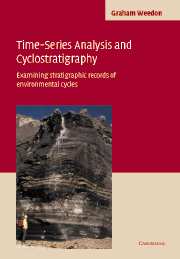Book contents
- Frontmatter
- Contents
- Preface
- Acknowledgements
- Chapter 1 Introduction
- Chapter 2 Constructing time series in cyclostratigraphy
- Chapter 3 Spectral estimation
- Chapter 4 Additional methods of time-series analysis
- Chapter 5 Practical considerations
- Chapter 6 Environmental cycles recorded stratigraphically
- Appendix – published algorithms for time-series analysis
- References
- Index
Appendix – published algorithms for time-series analysis
Published online by Cambridge University Press: 13 August 2009
- Frontmatter
- Contents
- Preface
- Acknowledgements
- Chapter 1 Introduction
- Chapter 2 Constructing time series in cyclostratigraphy
- Chapter 3 Spectral estimation
- Chapter 4 Additional methods of time-series analysis
- Chapter 5 Practical considerations
- Chapter 6 Environmental cycles recorded stratigraphically
- Appendix – published algorithms for time-series analysis
- References
- Index
Summary
Some readers will wish to use an existing commercial (e.g. Matlab, Origin, Statistica, SPSS) or internet-derived time-series package. Of the latter the ‘SSA-MTM Toolkit’ (at http://www.atmos.ucla.edu/tcd/ssa, see Dettinger et al., 1995), ‘Analyseries’ (at http://www.ngdc.noaa.gov/paleo/softlib.html, see Paillard et al., 1996) and ‘Arand’ (at http://www.ngdc.noaa.gov/paleo/softlib.html) all provide a variety of time series procedures. Additionally, http://paos.colorado.edu/research/wavelets allows wavelet analysis with the Morlet wavelets. However, the problem with using existing packages is that the speed with which output can be obtained might prevent the unwary from checking which procedures are being used. Always look inside the ‘black box’ if you can. In particular investigate the documentation to see whether, for example, the data are checked for uneven spacing (including values in the wrong order or multiple values at the same stratigraphic position or time). Will you be able to control the pre-processing of the data (e.g. interpolation, pre-whitening, detrending)? Are appropriate statistical tests available?
Of course the best way to learn how time series methods actually work is to look at the original coding and implement the data processing oneself. This appendix is designed to help this process and includes the algorithms adapted for generating the figures in this book. I have listed references of published FORTRAN algorithms that are in printed form.
Information
- Type
- Chapter
- Information
- Time-Series Analysis and CyclostratigraphyExamining Stratigraphic Records of Environmental Cycles, pp. 217 - 220Publisher: Cambridge University PressPrint publication year: 2003
